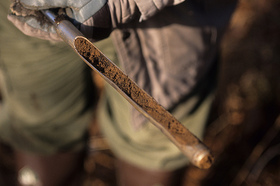The first step to determining how to clean up a contaminated site is to figure out just what contaminants are present. This happens by taking samples of the soil and groundwater. The sampling techniques used tell the sampling technician about the contaminants and the amount of contamination in a certain place.
Two of the more common methods for taking soil samples are grab sampling and split spoon sampling. Each brings its own advantages to the sampling process.
Grab Sampling
A grab sample is a single sample from one location using a scoop or another container. Any layering of materials is destroyed in the sampling process, offering a mixed sample for testing. This single sample offers a discrete snapshot of a single spot in the sampling area. Analysis offers a profile of that place's potential contaminants.
Grab sampling offers a way to track the spread of possible contamination in a larger area. Discrete grab samples taken at different points in the contaminated areas can show which contaminants are at what sampling points.
Another way sampling teams use grab sampling is to take a composite sample. The team takes discrete grab samples at random points in the suspected area of contamination. They then combine the samples and extract a new sample from the mixture. This sampling provides an average of contaminants on the site. It offers a profile of the contaminates in the sampled area.
Split Spoon Sampling
With split spoon sampling, the sampling team uses a drilling rig or a hand auger to drive a split spoon sampling device into unconsolidated, undisturbed soils. The device collects a vertical core within a sterile liner the team can extract and enclose for future testing. Split spoon sampling works best for lithological structure and chemical analysis.
Taking split spoon samples from various locations on a contamination site can determine how far and how deep contaminants have spread.
Sampling teams can also use this sampling technique to take a composite sample.They take split spoon samples from many points on the site. They then take smaller samples from each core at either varying or specific depths. The team mixes them together and takes a single composite sample from that mix. It offers an averaged profile of the site's potential contaminants.
Grab Sampling Versus Split Spoon Sampling
Grab sampling is good for collecting a discrete sample from one location in a possible contamination zone. It gives a snapshot of contamination at that spot. Split spoon sampling offers a vertical profile of the soil. Chemical analysis can happen at different levels in the soil to get snapshots at different lithological layers. Each is useful for taking composite samples.
The sampling team must take special care with each sampling method to get an accurate sample. The team uses decontaminated sampling equipment and immediately places the samples in an ice-chilled cooler for proper sample preservation. The team will maintain proper chain of custody of the samples until analytical testing can occur.
Contact Talon/LPE Drilling Services if you need environmental drilling services. Talon/LPE Drilling Services assists clients throughout Texas, New Mexico, and Oklahoma.
Two of the more common methods for taking soil samples are grab sampling and split spoon sampling. Each brings its own advantages to the sampling process.
Grab Sampling
A grab sample is a single sample from one location using a scoop or another container. Any layering of materials is destroyed in the sampling process, offering a mixed sample for testing. This single sample offers a discrete snapshot of a single spot in the sampling area. Analysis offers a profile of that place's potential contaminants.
Grab sampling offers a way to track the spread of possible contamination in a larger area. Discrete grab samples taken at different points in the contaminated areas can show which contaminants are at what sampling points.
Another way sampling teams use grab sampling is to take a composite sample. The team takes discrete grab samples at random points in the suspected area of contamination. They then combine the samples and extract a new sample from the mixture. This sampling provides an average of contaminants on the site. It offers a profile of the contaminates in the sampled area.
Split Spoon Sampling
With split spoon sampling, the sampling team uses a drilling rig or a hand auger to drive a split spoon sampling device into unconsolidated, undisturbed soils. The device collects a vertical core within a sterile liner the team can extract and enclose for future testing. Split spoon sampling works best for lithological structure and chemical analysis.
Taking split spoon samples from various locations on a contamination site can determine how far and how deep contaminants have spread.
Sampling teams can also use this sampling technique to take a composite sample.They take split spoon samples from many points on the site. They then take smaller samples from each core at either varying or specific depths. The team mixes them together and takes a single composite sample from that mix. It offers an averaged profile of the site's potential contaminants.
Grab Sampling Versus Split Spoon Sampling
Grab sampling is good for collecting a discrete sample from one location in a possible contamination zone. It gives a snapshot of contamination at that spot. Split spoon sampling offers a vertical profile of the soil. Chemical analysis can happen at different levels in the soil to get snapshots at different lithological layers. Each is useful for taking composite samples.
The sampling team must take special care with each sampling method to get an accurate sample. The team uses decontaminated sampling equipment and immediately places the samples in an ice-chilled cooler for proper sample preservation. The team will maintain proper chain of custody of the samples until analytical testing can occur.
Contact Talon/LPE Drilling Services if you need environmental drilling services. Talon/LPE Drilling Services assists clients throughout Texas, New Mexico, and Oklahoma.


